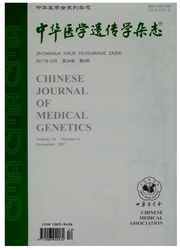

 中文摘要:
中文摘要:
目的研究中国南方湖南地区汉族人群HLA Ⅰ类区远着丝粒端D6S1624、D6S258、M6S211、D6S510遗传多态性及与HLA-A的连锁不平衡。方法应用荧光聚合酶链式反应.基因分型和聚合酶链式反应-序列特异性引物技术分别检测湖南地区227份正常人群样本D6S1624、D6S258、M6S211、D6S510和HLA-A位点。结果5个位点基因型分布均符合Hardy-Weinberg平衡(P〉0.05)。在D6S1624、D6S258、M6S211和D6S510位点分别检出10、10、12、9种等位基因,各位点均有若干主要等位基因,分别以D6S1624-*199、D6S258-*195、M6S211-*261、D6S510-*186最为常见。在该人群中,4个微卫星位点均具有较高的杂合度值(O.7142—0.8316)和多态性信息含量(0.6686—0.811),属高度多态性位点。D6S1624、D6S258位点与HLA-A位点之间均不存在总体连锁不平衡(P=0.2646;P=0.3481),M6S211、D6S510位点与HLA-A位点之间均存在非常显著的总体连锁不平衡(P〈0.0001;P〈0.0001)。对观察频率≥3%的所有单倍型做连锁不平衡分析,显示10种D6S1624-HLA-A单倍型中,仅两种处于连锁不平衡状态;9种D6S258-HLA-A单倍型中,仅3种处于连锁不平衡;而8种M6S211-HLA-A单倍型、7种D6SSl0-HLA-A单倍型中,分别有7种、6种均处于连锁不平衡状态。结论所获得的4个微卫星标记的群体遗传学数据将有助鉴定HLAI区域内与疾病相关(如鼻咽癌)的遗传标志、法医学个体认定、人类学研究,亦将有助于评价、指导临床器官移植的组织相容性配型。
 英文摘要:
英文摘要:
Objective To explore the genetic polymorphisms of four micrasatellite DNA markers from telomeric HLA I region (D6S1624, D6S.258, M6S211 and D6S510) and their linkage disequilibrium with HLA-A in a southern Chinese Han population residing in Hunan province. Methods Fluorescent PCR/Size-sequencing was carried out to analyze the polymorphisms of D6S1624, D6S258, M6S211 and D6S510 loci, and polymerase chain reaction-sequence specific priming (PCR-SSP) technique was used for HLA-A typing. Results The genotypic distributions at the 5 loci were consistent with Hardy-Weinberg equilibrium (P 〉 0.05). The number of allelic variants for D6S1624, D6S258, M6S211 and D6S510 loci were 10, 10, 12 and 9, respectively. Each locus had several main alleles and the dominant alleles were D6S1624- * 199, D6S.258- * 195, M6S211- * 261 and D6S510- * 186. All of the 4 microsatellite markers exhibited high heterozygosity values (0.7142-0. 8316) and polymorphism information content values (0.6686-0. 811). No global linkage disequilibrium (LD) was detected between D6S1624 and HLA-A ( P = 0. 2646), or between D6S258 and HLA-A( P=0.3481). In contrast, very significant global LD was found between M6S211 and HLA-A( P 〈 0.0001 ), and between D6S510 and HLA-A( P 〈 0. 0001 ). Subsequent analysis for haplotypes with an observed frequency of ≥ 3% revealed that only 2 of the 10 D6S1624-HLA-A haplotypes and 3 of the 9 D6S258-HLA-A haplotypes displayed weak or moderate LD, while 7 out of the 8 M6S211-HLA-A haplotypes, 6 among the 7 D6S510-HLA-A haplotypes were in tight LD. Conclusion Authors have characterized four microsatellite DNA markers, D6S1624, D6S258, M6S211 and D6S510 in a southern Chinese Hart population. Findings shown here can be helpful for those studies mainly addressing the association between HLA I sub-region and diseases. The data also provide basis for future study in forensics, HLA matching in clinical transplantation and anthropology.
 同期刊论文项目
同期刊论文项目
 同项目期刊论文
同项目期刊论文
 期刊信息
期刊信息
